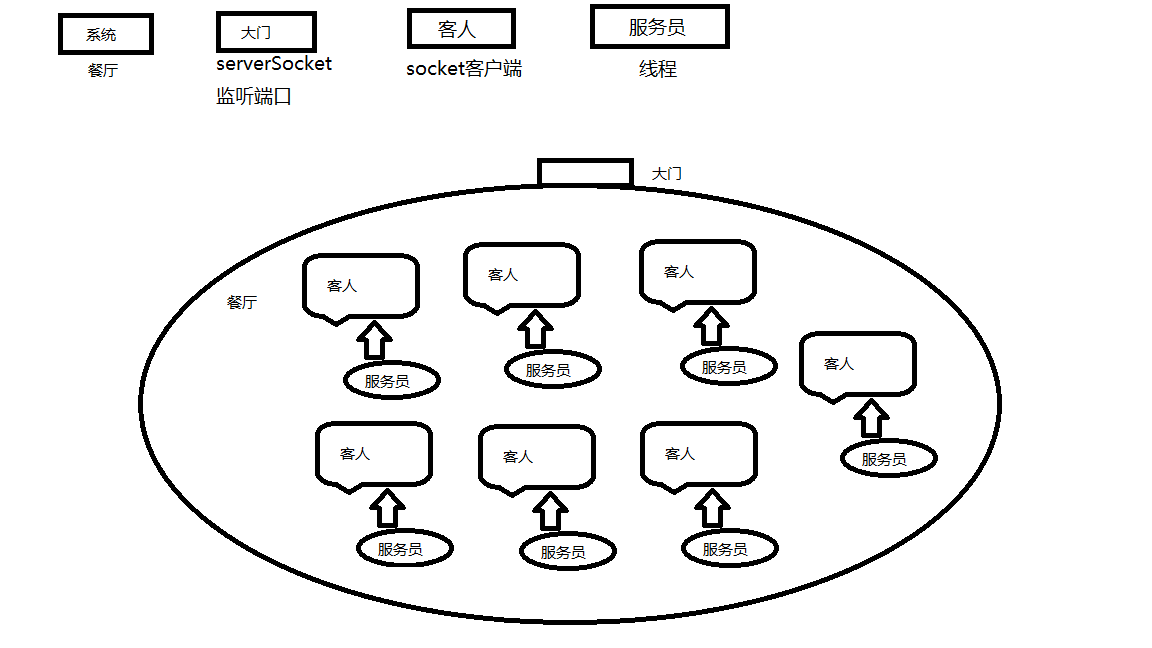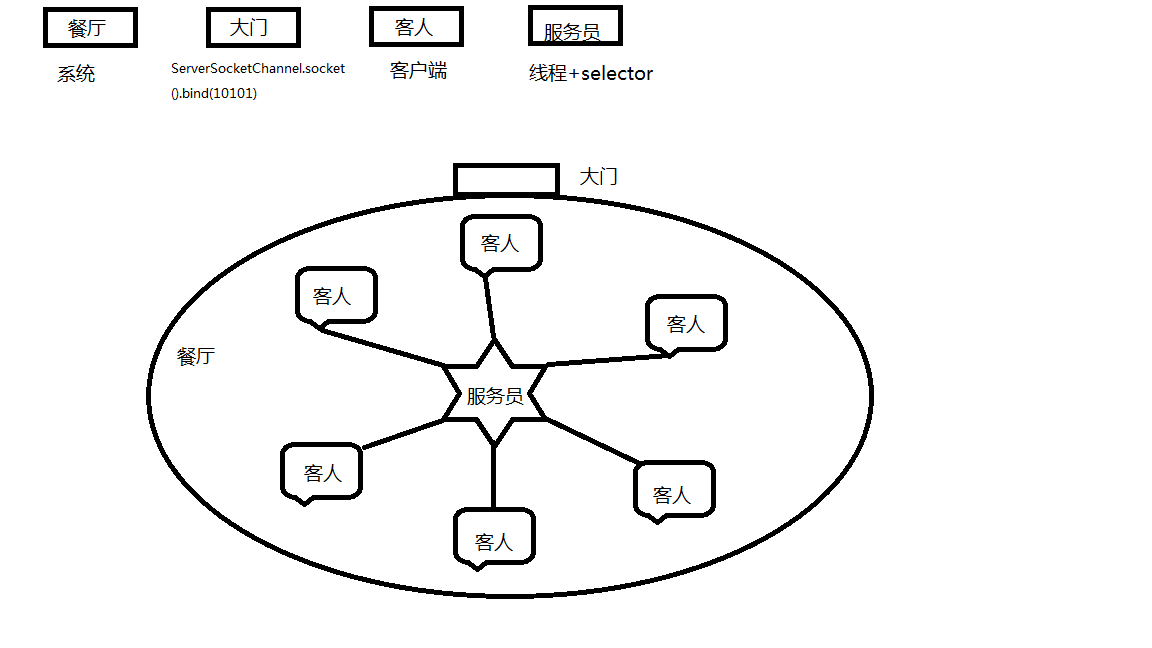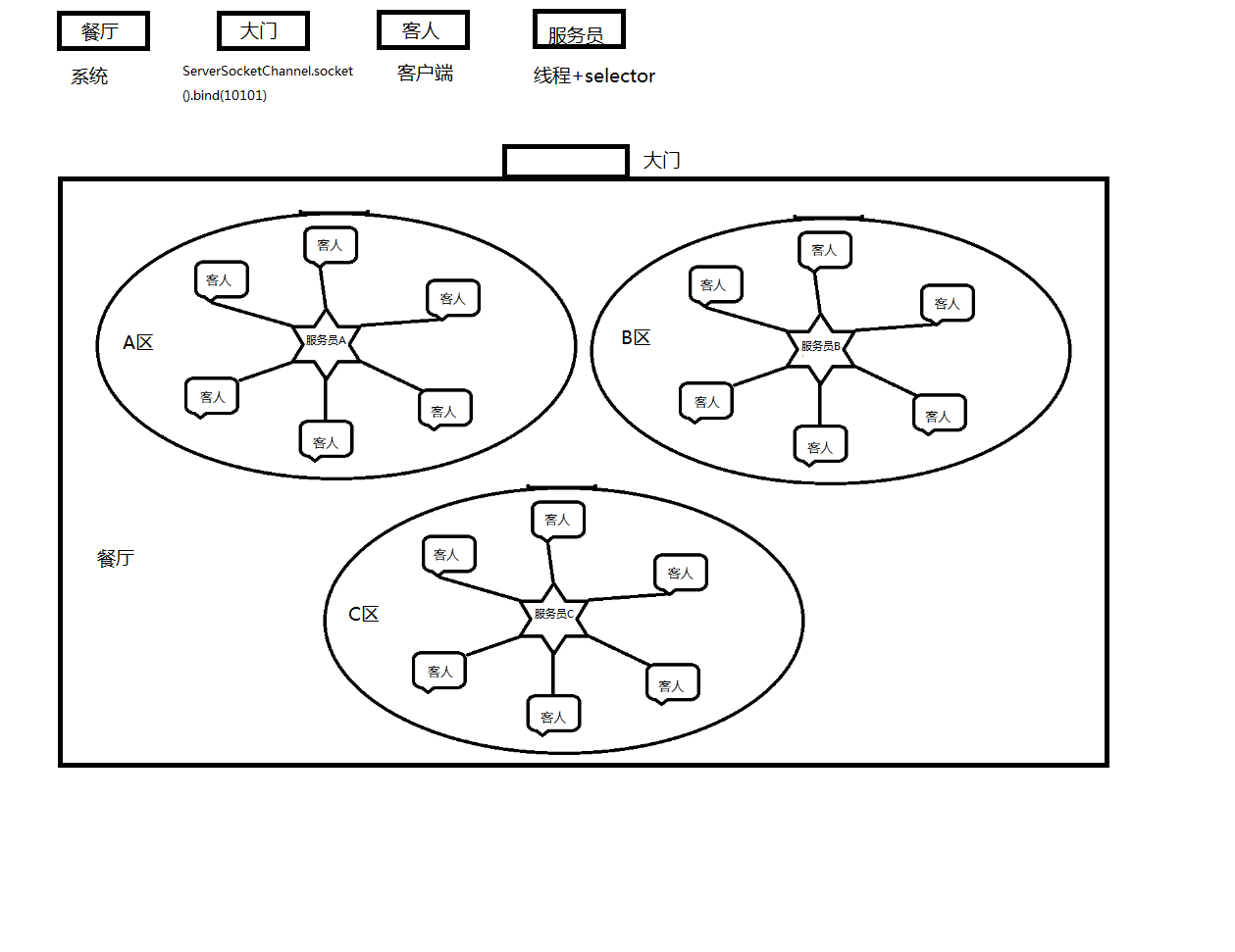单线程处理
package one;
import java.io.IOException;
import java.net.InetSocketAddress;
import java.nio.ByteBuffer;
import java.nio.channels.SelectionKey;
import java.nio.channels.Selector;
import java.nio.channels.ServerSocketChannel;
import java.nio.channels.SocketChannel;
import java.util.Iterator;
/**
* nio单线程处理
*/
public class NioService1 {
//通道管理器
private Selector selector;
public static void main(String[] args) throws IOException {
NioService1 nioService3 = new NioService1();
nioService3.initServer(8000);
nioService3.listen();
}
/**
* 获得一个ServerSocket通道,并对该通道做一些初始化的工作
* @param port 绑定的端口号
*/
public void initServer(int port) throws IOException {
//获得一个ServerSocket通道
ServerSocketChannel serverSocketChannel = ServerSocketChannel.open();
//设置通道为非阻塞
serverSocketChannel.configureBlocking(false);
//将该通道对应的ServerSocket绑定到port端口
serverSocketChannel.socket().bind(new InetSocketAddress(port));
//获得一个通道管理器
this.selector = Selector.open();
//将通道管理器和该通道绑定,并为该通道注册SelectionKey.OP_ACCEPT事件,注册该事件后
//当该事件到达时,selector.select()会返回,如果该事件没有到达selector.select()会一直阻塞
serverSocketChannel.register(selector,SelectionKey.OP_ACCEPT);
}
/**
* 采用轮询的方式监听selector上是否有需要处理的事件,如果有,则进行处理
*/
public void listen() throws IOException {
System.out.println("服务器启动成功!");
//轮询访问selector
while (true){
//当注册的事件到达时,方法返回,否则,该方法会一直阻塞
selector.select();
//获得selector中选中的项的迭代器,选中的项为注册的事件
Iterator iterator = this.selector.selectedKeys().iterator();
while (iterator.hasNext()){
SelectionKey selectionKey = (SelectionKey) iterator.next();
//删除已选的key,以防重复处理
iterator.remove();
handler(selectionKey);
}
}
}
/**
* 处理请求
* @param selectionKey
*/
public void handler(SelectionKey selectionKey) throws IOException {
if(selectionKey.isAcceptable()){
//客户端请求连接事件
handlerAccept(selectionKey);
}else if(selectionKey.isReadable()){
//获得了可读的事件
handlerRead(selectionKey);
}
}
/**
* 处理连接请求
* @param selectionKey
*/
public void handlerAccept(SelectionKey selectionKey) throws IOException {
ServerSocketChannel serverSocketChannel = (ServerSocketChannel) selectionKey.channel();
//获得和客户端连接的通道
SocketChannel socketChannel = serverSocketChannel.accept();
//设置成非阻塞
socketChannel.configureBlocking(false);
//在这里可以给客户端发送信息
System.out.println("新的客户端连接");
//在和客户端连接成功之后,为了可以接收到客户端的信息,需要给通道设置读的权限
socketChannel.register(this.selector,SelectionKey.OP_READ);
}
/**
* 处理读的事件
* @param selectionKey
*/
public void handlerRead(SelectionKey selectionKey) throws IOException {
//服务器可读取消息:得到事件发生的Socket通道
SocketChannel socketChannel = (SocketChannel) selectionKey.channel();
//创建读取的缓冲区:缓冲小的话,一次获取不完所有的数据
ByteBuffer byteBuffer = ByteBuffer.allocate(1024);
int intRead = socketChannel.read(byteBuffer);
if(intRead > 0){
byte[] data = byteBuffer.array();
String msg = new String(data).trim();
System.out.println("服务端收到信息:"+msg);
//会写数据
ByteBuffer outByteBuffer = ByteBuffer.wrap("好的".getBytes());
//将消息会送给客户端
socketChannel.write(outByteBuffer);
}else{
System.out.println("客户端关闭");
selectionKey.cancel();
}
}
}该实例是BIO的简单实现,是一个线程+selector的实现,这种方式可以实现同时处理多个客户端请求的需求。在这个实例中我们可以知道,获得客户端请求的方法也是阻塞的,那为什么说这个实例就是NIO呢?这里需要注意,区别NIO和BIO的点,不是获得客户端请求时是否阻塞(当然,NIO可以设置成非阻塞或者被唤醒),而是在读取客户端数据时,是否可以立即返回,即:读取客户端数据时是否阻塞,BIO在读取客户端发送的数据时是阻塞的,NIO在读取客户端发送的数据时是非阻塞的。
上面demo中存在一个问题,读取一个客户端发送的数据后,如果在处理这一个客户端的数据上用了1分钟,那么,在这1分钟内,该服务端无法进行其它任何事(不可以直接)
多线程处理
单线程+selector的方式,可以解决同时处理多个客户端的请求,但是存在如上所述的问题,对于解决的方法,相信大家也都知道,就是采用多线程的方式。
/**
* 采用轮询的方式监听selector上是否有需要处理的事件,如果有,则进行处理
*/
public void listen() throws IOException {
System.out.println("服务器启动成功!");
//轮询访问selector
while (true){
//当注册的事件到达时,方法返回,否则,该方法会一直阻塞
selector.select();//当发现客户端还没有处理时,就不会阻塞
//获得selector中选中的项的迭代器,选中的项为注册的事件
Iterator iterator = this.selector.selectedKeys().iterator();
while (iterator.hasNext()){
SelectionKey selectionKey = (SelectionKey) iterator.next();
//删除已选的key,以防重复处理
iterator.remove();
//业务处理
executorService.execute(new Runnable() {
@Override
public void run() {
try {
handler(selectionKey);
} catch (IOException e) {
e.printStackTrace();
}
}
});
}
}
}如果实现NIO的多线程处理呢,采用的思路是使用多个selector,一个selector仅监听客户端链接,业务处理是多个线程,每个线程一个selector。当监听到客户端链接后,就把客户端交给一个业务线程的selector。
BIO和NIO
我们可以做一个比喻,我们把我们的服务器端系统作为餐厅,把餐厅的大门作为监听的端口,客人为socket客户端,一个服务员为一个线程。
BIO的多线程实现图,大门有一个服务,里面是一个客人一个服务员。
BIO的单线程实现图,该餐厅就一个服务员,该服务员在大门迎接客人,又在里面服务客人。
BIO的多线程实现图,门口一个服务员,里面一个服务员负责一个区,该去内的所有客人都给该服务员服务。
总结
通过上面的图,我们可以知道,java的NIO的多线程是较好的一种服务方式,netty就是采用的这种方式,通过对java的nio进行相应的代码封装,而实现的一种NIO框架。

























 2077
2077

 被折叠的 条评论
为什么被折叠?
被折叠的 条评论
为什么被折叠?








